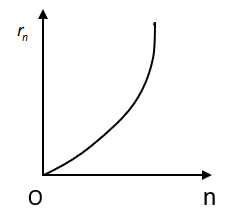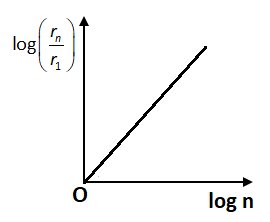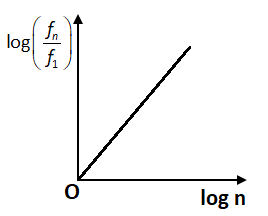
If in hydrogen atom, radius of
A. 
B. 
C. 
D. Both A and B
Answer
139.8k+ views
Hint:To find the correct graph we need to use the equation for radius of orbit given by Bohr's atomic theory so that we get the relationship between the terms like radius of the orbit, principal quantum number(n), atomic number(Z) and frequency(f).
Formula used:
According to the Bohr's atomic theory,
Where n is an integer,
Complete step by step solution:
Let us understand each option one by one. As we know from Bohr's atomic theory,
Here the radius of
Also, we can also write
Now the ratio is given as,
By comparing this equation with the straight-line equation
Similarly, the graph between
Hence option D is the correct answer.
Note: The Bohr model of an atom came into existence with some modification of Rutherford’s model of an atom. Bohr’s theory modified the atomic structure of the model by explaining that electrons will move in fixed orbitals or shells and each of the orbitals or shells has its fixed energy.
Formula used:
According to the Bohr's atomic theory,
Where n is an integer,
Complete step by step solution:
Let us understand each option one by one. As we know from Bohr's atomic theory,
Here the radius of
Also, we can also write
Now the ratio is given as,
By comparing this equation with the straight-line equation
Similarly, the graph between
Hence option D is the correct answer.
Note: The Bohr model of an atom came into existence with some modification of Rutherford’s model of an atom. Bohr’s theory modified the atomic structure of the model by explaining that electrons will move in fixed orbitals or shells and each of the orbitals or shells has its fixed energy.
Latest Vedantu courses for you
Grade 10 | MAHARASHTRABOARD | SCHOOL | English
Vedantu 10 Maharashtra Pro Lite (2025-26)
School Full course for MAHARASHTRABOARD students
₹31,500 per year
EMI starts from ₹2,625 per month
Recently Updated Pages
Average fee range for JEE coaching in India- Complete Details

Difference Between Rows and Columns: JEE Main 2024

Difference Between Length and Height: JEE Main 2024

Difference Between Natural and Whole Numbers: JEE Main 2024

Algebraic Formula

Difference Between Constants and Variables: JEE Main 2024

Trending doubts
JEE Main 2025 Session 2: Application Form (Out), Exam Dates (Released), Eligibility, & More

JEE Main 2025: Derivation of Equation of Trajectory in Physics

A point charge + 20mu C is at a distance 6cm directly class 12 physics JEE_Main

JEE Main Exam Marking Scheme: Detailed Breakdown of Marks and Negative Marking

Learn About Angle Of Deviation In Prism: JEE Main Physics 2025

Electric Field Due to Uniformly Charged Ring for JEE Main 2025 - Formula and Derivation

Other Pages
JEE Advanced Marks vs Ranks 2025: Understanding Category-wise Qualifying Marks and Previous Year Cut-offs

JEE Main 2025: Conversion of Galvanometer Into Ammeter And Voltmeter in Physics

Degree of Dissociation and Its Formula With Solved Example for JEE

Electric field due to uniformly charged sphere class 12 physics JEE_Main

Dual Nature of Radiation and Matter Class 12 Notes: CBSE Physics Chapter 11

Formula for number of images formed by two plane mirrors class 12 physics JEE_Main




